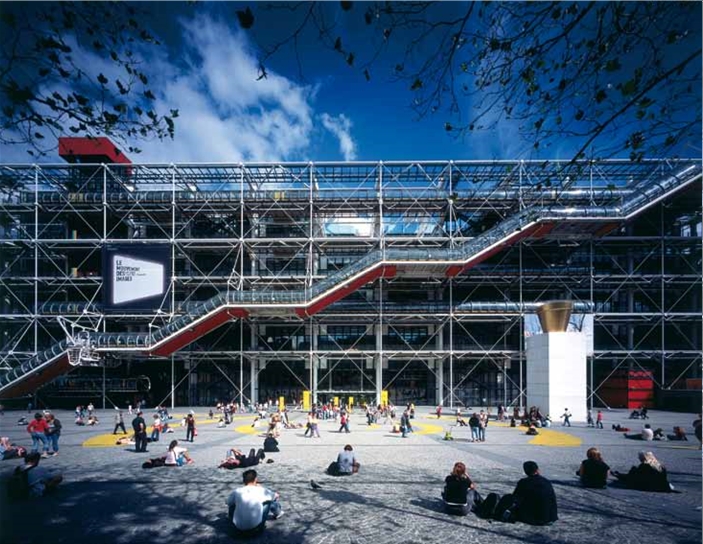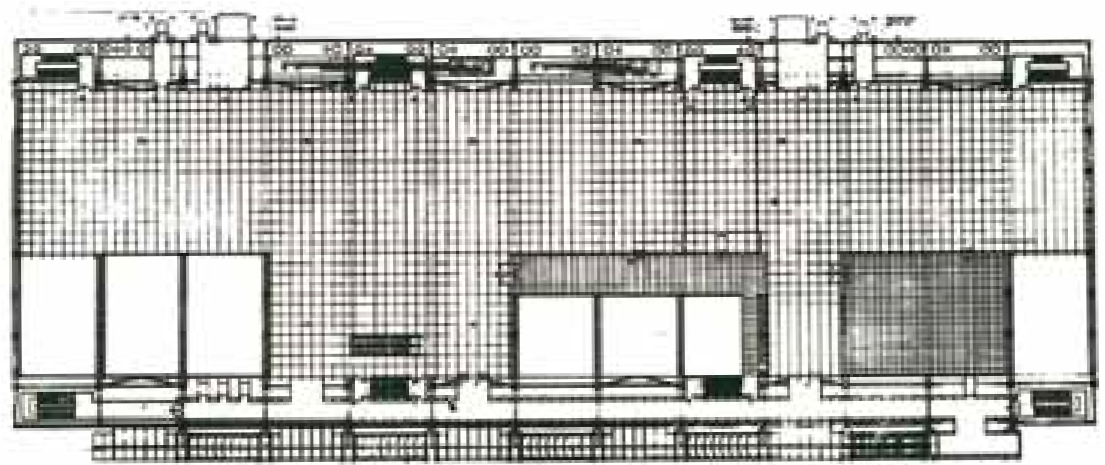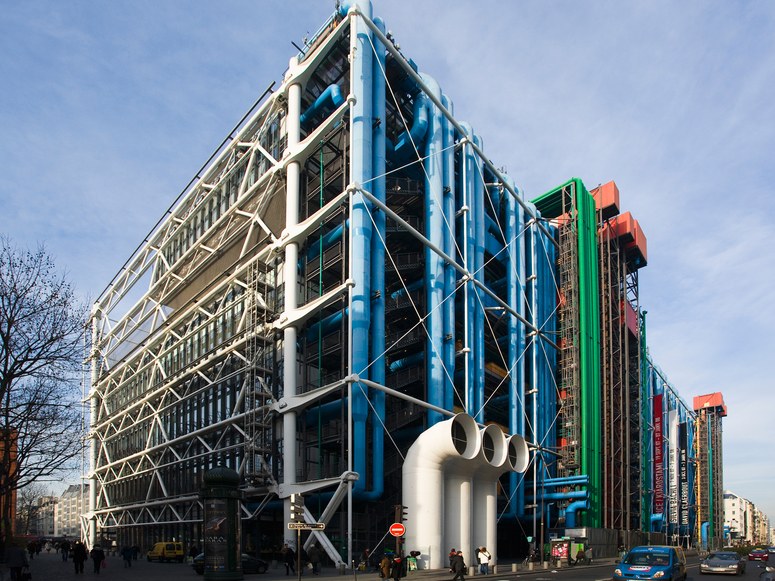Centre Pompidou
Centre Georges Pompidou (popularly known as Centre Pompidou) is a complex high-tech building in the Beaubourg area of Paris. It was designed by the architectural team of Richard Rogers and Renzo Piano, along with Gianfranco Franchini, and was completed in 1977, becoming one of the most famous and provocative buildings of the 20th century.
It houses the Bibliothèque publique d'information (Public Information Library), a vast public library, the Musée National d'Art Moderne, which is the largest museum for modern art in Europe, and IRCAM, a centre for music and acoustic research.
The design created a flexible and a dynamic communications centre. A large piazza for public activities and glazed street animate the façade of one of the most visited cultural centres in the world.
The Centre Pompidou brings together the themes which have characterised Rogers’ architecture from the mid 1960s – skin and structure, technology and flexibility, movement and anti-monumentalism. The building was envisaged as a cross between ‘an information-oriented computerised Times Square and the British Museum’, a democratic place for all people and the centrepiece of a regenerated quarter of the city.
Half of the total available site area was set aside as a public square, therefore the Centre had to be tall enough to accommodate 90,000 m2 (one million ft2) of space. The decision to place structure and services on the outside was driven by the need for internal flexibility, as a result providing huge expanses of uninterrupted space on massive, open floors – the staggering scale of these internal spaces is free from the intrusion of services and stairs.
The structural system provided for a braced and exposed steel superstructure with reinforced concrete floors. External services give scale and detail to the façades, while celebration of movement and access is provided by lifts and escalators. The result is a highly expressive, strongly articulated building that has come to be seen as a Parisian landmark.
Yet the achievement at Beaubourg is urbanistic as much as architectural. The building and great public square were intended to revitalise an area of Paris that had been in decline. The neighbouring Marais district, now vibrant and multicultural, underlines the success of the Pompidou’s role as a catalyst for urban regeneration.
The Pompidou’s radicalism is still striking and has proved attractive to a vast public: more than seven million people visit the building every year. The building and its extraordinary contents remain as popular as ever, while crowds fill the square, clustering around musicians, acrobats and fire-eaters. Beaubourg – inside and out – remains as magnetic as ever.
- Place/Date: Paris, France 1971—1977
- Client: Ministère des Affaires Culturelles, Ministère de l’Education Nationale
- Architect: Piano + Rogers
- Cost: £58 million
- Gross Internal Area: 100,000m²
- Structural Engineer: Ove Arup & Partners
- Services Engineer: Ove Arup & Partners
- Quantity Surveyor: Ove Arup & Partners
- Mechanical Services & Superstructure: Laurie Abbott with Shunji Ishida, Hiroshi Naruse, Hiroyuki Takahashi
- Mechanical Engineer: Walter Zbinden with Hans-Peter Bysaeth, Johanna Lohse, Peter Merz, Philippe Dupont
- Site Management: Bernard Plattner
- Main Contractor: Grands Travaux de Marseilles
- Internal & External Systems/Audio Visual: Alan Stanton with Michael Dowd, William Logan, Noriaki Okabe, Rainer Verbizh
- Interior Design: Gianfranco Franchini
Click here to see the full job sheet.

 --Rogers Stirk Harbour + Partners 11:36, 11 March 2015 (UTC)
--Rogers Stirk Harbour + Partners 11:36, 11 March 2015 (UTC)
[edit] Related articles on Designing Buildings Wiki
- Archigram.
- Dali Theatre and Museum.
- Eiffel Tower.
- Engineering the World - VandA Museum.
- Exoskeleton.
- Guggenheim Museum, Bilbao.
- High-tech architecture.
- Lloyds of London.
- McArthurGlen Designer Outlet Ashford.
- Renzo Piano.
- Richard Rogers.
- Richard Rogers - A Place for all People.
- Robot Building, Bangkok.
- RSHP.
- Solomon R. Guggenheim Museum.
- Switch House, Tate Modern.
- Titanic Belfast.
Featured articles and news
Latest Build UK Building Safety Regime explainer published
Key elements in one short, now updated document.
UKGBC launch the UK Climate Resilience Roadmap
First guidance of its kind on direct climate impacts for the built environment and how it can adapt.
CLC Health, Safety and Wellbeing Strategy 2025
Launched by the Minister for Industry to look at fatalities on site, improving mental health and other issues.
One of the most impressive Victorian architects. Book review.
Common Assessment Standard now with building safety
New CAS update now includes mandatory building safety questions.
RTPI leader to become new CIOB Chief Executive Officer
Dr Victoria Hills MRTPI, FICE to take over after Caroline Gumble’s departure.
Social and affordable housing, a long term plan for delivery
The “Delivering a Decade of Renewal for Social and Affordable Housing” strategy sets out future path.
A change to adoptive architecture
Effects of global weather warming on architectural detailing, material choice and human interaction.
The proposed publicly owned and backed subsidiary of Homes England, to facilitate new homes.
How big is the problem and what can we do to mitigate the effects?
Overheating guidance and tools for building designers
A number of cool guides to help with the heat.
The UK's Modern Industrial Strategy: A 10 year plan
Previous consultation criticism, current key elements and general support with some persisting reservations.
Building Safety Regulator reforms
New roles, new staff and a new fast track service pave the way for a single construction regulator.
Architectural Technologist CPDs and Communications
CIAT CPD… and how you can do it!
Cooling centres and cool spaces
Managing extreme heat in cities by directing the public to places for heat stress relief and water sources.
Winter gardens: A brief history and warm variations
Extending the season with glass in different forms and terms.
Restoring Great Yarmouth's Winter Gardens
Transforming one of the least sustainable constructions imaginable.
























